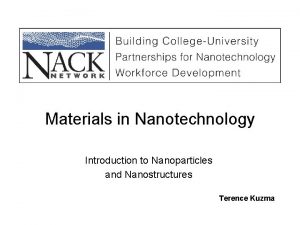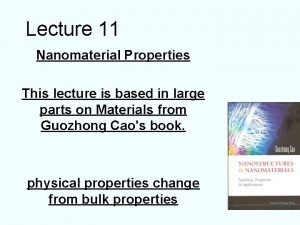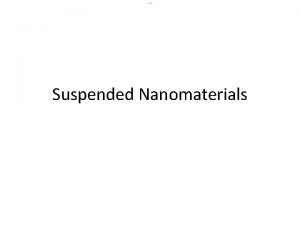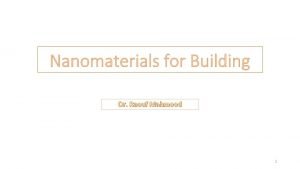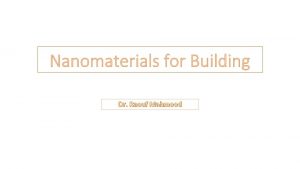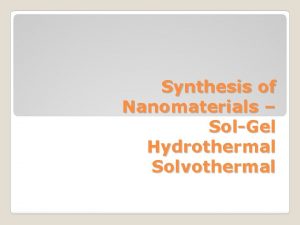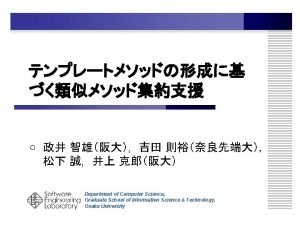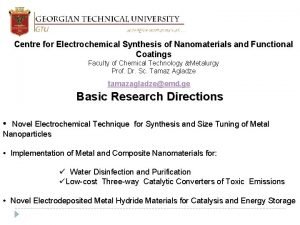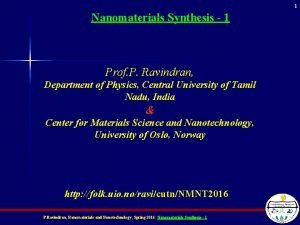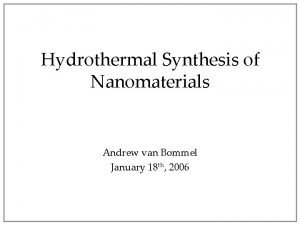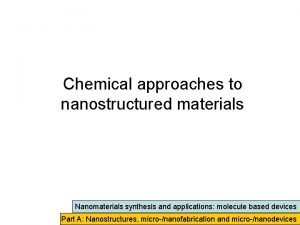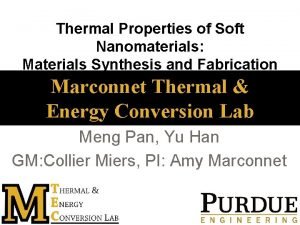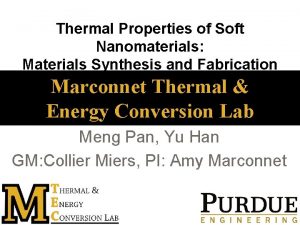Template method for synthesis of Nanomaterials Introduction Template












- Slides: 12

Template method for synthesis of Nanomaterials

Introduction • Template synthesis of nanomaterials has been a cutting edge technology developed since the 1990 s. • It is also a very effective nanomaterials synthesis method that has been widely used in recent years. • Early in 1999, South Korean scientists Kim et al. took MCM-48 mesoporous silica as template and synthesized three-dimensional cubic mesoporous carbon CMK-1.

Template method • is not sensitive regarding the preparation conditions • easy to operate and implement • controls the structure, morphology, and particle size of nanomaterials through the template material (template). Template method is often divided into hard and soft template methods.

Morphology is an important parameter for characterization of material properties, especially in the mesoporous material. Morphology, together with particle size, surface area, and pore structure, determines the property of mesoporous materials and, consequently, pinpoints their application. Among this, mesoporous thin films, as film like material, have an unparalleled advantage in adsorption and separation compared to the other nanomaterials with different shapes. The template method changes the morphology of products, mainly, by controlling the crystal nucleation and growth during nanomaterial preparation.

Template type The choice of template for nanomaterial preparation is critical. Templates usually can be grouped in two major categories: Ø Natural substances (nano-mineral, biological molecules, cells and tissues, etc. ) Ø Synthetic materials (surface active agents, porous materials and nanoparticles, etc. ) In addition, the templates are generally divided into two groups: Ø Hard template Ø Soft template based on the difference in the template structure Surface active agents (surfactants) are amphiphilic compounds with two opposing portions, one part is hydrophilic and the other is hydrophobic.

Method Route of nanomaterial synthesis by using the template method is generally divided into three steps: ü First, the template is prepared. ü Second, some common synthetic approach such as hydrothermal method, precipitation, and sol-gel method is used to synthesize the target production under the function of template. ü Finally, the third step is the template removal.

Template removal is the last step in the synthesis of nanomaterials. The appropriate method of removal has to be chosen - the physical and chemical properties of the product should not be affected. Common removal methods include physical and chemical methods, such as dissolution, sintering, and etching.

Hard Template Hard template is a rigid material, whose stable structure directly determines the size and morphology of sample particle. A wide choice of hard templates is available, such as o polymer microspheres o porous membrane o plastic foam o ion exchange resin o carbon fiber o porous anodic aluminum oxide

Soft Template The soft template does not have a fixed rigid structure. In the synthesis of nanoparticles, an aggregate with some certain structural features is formed by means of the intermolecular or intramolecular interaction force (hydrogen bonding, chemical bonding, and static electricity). Using these aggregates as a template, inorganic species are deposited on the surface or the interior of these templates by means of electrochemical method, precipitation, and other synthetic methods, forming particles with certain shape and size. Common soft template can be a surfactant, polymer and biopolymer, and so forth.



 Nanomaterials example
Nanomaterials example Mechanical properties of nano materials
Mechanical properties of nano materials Magnetic properties of nanomaterials
Magnetic properties of nanomaterials Synthesis matrix template
Synthesis matrix template Symposium teaching method
Symposium teaching method Formuö
Formuö Novell typiska drag
Novell typiska drag Nationell inriktning för artificiell intelligens
Nationell inriktning för artificiell intelligens Returpilarna
Returpilarna Shingelfrisyren
Shingelfrisyren En lathund för arbete med kontinuitetshantering
En lathund för arbete med kontinuitetshantering Särskild löneskatt för pensionskostnader
Särskild löneskatt för pensionskostnader Tidböcker
Tidböcker
